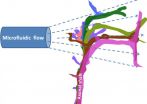(Press-News.org) Rabies causes acute inflammation of the brain, producing psychosis and violent aggression. The virus, which paralyzes the body's internal organs, is always deadly for those unable to obtain vaccines in time. Some 55,000 people die from rabies every year.
For the first time, Tel Aviv University scientists have discovered the exact mechanism this killer virus uses to efficiently enter the central nervous system, where it erupts in a toxic explosion of symptoms. The study, published in PLOS Pathogens, was conducted by Dr. Eran Perlson and Shani Gluska of TAU's Sackler Faculty of Medicine and Sagol School of Neuroscience, in collaboration with the Friedrich Loeffler Institute in Germany.
"Rabies not only hijacks the nervous system's machinery, it also manipulates that machinery to move faster," said Dr. Perlson. "We have shown that rabies enters a neuron in the peripheral nervous system by binding to a nerve growth factor receptor, responsible for the health of neurons, called p75. The difference is that its transport is very fast, even faster than that of its endogenous ligand, the small molecules that travel regularly along the neuron and keep the neuron healthy."
Faster than a speeding train
To track the rabies virus in the nervous system, the researchers grew mouse sensory neurons in an observation chamber and used live cell imaging to track the path taken by the virus particles. The researchers "saw" the virus hijack the "train" transporting cell components along a neuron and drove it straight into the spinal cord. Once in the spinal cord, the virus caught the first available train to the brain, where it wrought havoc before speeding through the rest of the body, shutting it down organ by organ.
Nerve cells, or neurons, outside the central nervous system are highly asymmetric. A long protrusion called an axon extends from the cell body to another nerve cell or organ along a specific transmission route. In addition to rapid transmission of electric impulses, axons also transport molecular materials over these distances.
"Axonal transport is a delicate and crucial process for neuronal survival, and when disrupted it can lead to neurodegenerative diseases," said Dr. Perlson. "Understanding how an organism such as rabies manipulates this machinery may help us in the future to either restore the process or even to manipulate it to our own therapeutic needs."
Hijacking the hijacker
"A tempting premise is to use this same machinery to introduce drugs or genes into the nervous system," Dr. Perlson added. By shedding light on how the virus hijacks the transport system in nerve cells to reach its target organ with maximal speed and efficiency, the researchers hope their findings will allow scientists to control the neuronal transport machinery to treat rabies and other neurodegenerative diseases.
Disruptions of the neuron train system also contribute to neurodegenerative diseases, like Alzheimer's disease, Parkinson's disease, and amyotrophic lateral sclerosis (ALS). According to Dr. Perlson, "An improved understanding of how the neuron train works could lead to new treatments for these disorders as well."
INFORMATION:
American Friends of Tel Aviv University supports Israel's leading, most comprehensive and most sought-after center of higher learning, Tel Aviv University (TAU). Rooted in a pan-disciplinary approach to education, TAU is internationally recognized for the scope and groundbreaking nature of its research and scholarship — attracting world-class faculty and consistently producing cutting-edge work with profound implications for the future. TAU is independently ranked among the world's top universities and #1 in Israel. It joins a handful of elite international universities that rank among the best producers of successful startups.
How rabies 'hijacks' neurons to attack the brain
Groundbreaking Tel Aviv University study tracks precise path of deadly virus to the central nervous system
2014-10-06
ELSE PRESS RELEASES FROM THIS DATE:
Penn Medicine study finds tongue fat and size may predict sleep apnea in obese adults
2014-10-06
Obesity is a risk factor for many health problems, but a new Penn Medicine study published this month in the journal Sleep suggests having a larger tongue with increased levels of fat may be a sign of obstructive sleep apnea (OSA) in obese adults.
The researchers examined tongue fat in 31 obese adults who had OSA and 90 obese adults without the condition. All subjects underwent magnetic resonance imaging and the size and distribution of upper airway fat deposits in their tongue and upper airway muscles measured.
"Previous studies showed that the human tongue has a high ...
UT Arlington researchers demonstrate direct fluid flow influences neuron growth
2014-10-06
A University of Texas at Arlington team exploring how neuron growth can be controlled in the lab and, possibly, in the human body has published a new paper in Nature Scientific Reports on how fluid flow could play a significant role.
In a new study co-authored by Samarendra Mohanty, leader of the Biophysics and Physiology Lab in the College of Science, the researchers were able to use microfluidic stimulations to change the path of an axon at an angle of up to 90 degrees. Axons are the shafts of neurons, on the tips of which connections are made with other neurons or cells. ...
Are leaders born or made? New study shows how leadership develops
2014-10-06
URBANA, Ill. – Hardly a day passes without pundits crying for leadership in the NFL commissioner and team owners, among high-ranking government officials, and in other public figures. If University of Illinois experts didn't have evidence that this valuable trait can be taught, they might join the collective swoon that's engulfing much of the country.
But a new U of I study supports the idea that leaders are made, not born, and that leadership development follows a specific progression.
Past research suggests that leadership is 30 percent genetic and 70 percent a result ...
Natural gene selection can produce orange corn rich in provitamin A for Africa, US
2014-10-06
WEST LAFAYETTE, Ind. - Purdue researchers have identified a set of genes that can be used to naturally boost the provitamin A content of corn kernels, a finding that could help combat vitamin A deficiency in developing countries and macular degeneration in the elderly.
Professor of agronomy Torbert Rocheford and fellow researchers found gene variations that can be selected to change nutritionally poor white corn into biofortified orange corn with high levels of provitamin A carotenoids - substances that the human body can convert into vitamin A. Vitamin A plays key roles ...
Montefiore & Einstein investigators present research at 2014 AAP National Conference & Exhibition
2014-10-06
NEW YORK (October 6, 2014) – Investigators at The Children's Hospital at Montefiore (CHAM) and Albert Einstein College of Medicine of Yeshiva University will present their latest research on neonatal lung disease, reducing wrong-patient errors in the NICU, hormonal contraception and more at the AAP Experience, the National Conference & Exhibition of the American Academy of Pediatrics. The AAP Experience will take place October 11-14 in San Diego, California.
Judy Aschner, M.D., F.A.A.P., physician-in-chief, CHAM, professor of pediatrics and Michael I. Cohen, M.D., University ...
Less than half of Canadians exercise to relieve stress
2014-10-06
Hamilton, ON (October 6, 2014) – A research study out of McMaster University has found that only 40 per cent of Canadians exercise to cope with stress.
The researchers analyzed data from Statistics Canada's Canadian Community Health Survey of nearly 40,000 Canadians 15 and older. Of 13 coping behaviours or strategies polled, exercise was ranked eighth, meaning people were more likely to cope with stress by problem-solving; looking on the bright side, trying to relax, talking to others, blaming oneself, ignoring stress or praying, rather than being active.
"We know ...
New theorem determines the age distribution of populations from fruit flies to humans
2014-10-06
AUGUSTA, Ga. - The initial motivation was to estimate the age structure of a fruit fly population, the result a fundamental theorem that can help determine the age distribution of essentially any group.
This emerging theorem on stationary populations shows that you can determine the age distribution of a population by looking at how long they still have to live.
The mathematical discovery can help produce data with a wide range of implications, from predicting rates of infectious diseases, such as West Nile virus spread by mosquitoes, to anticipating the health care ...
The skin cancer selfie
2014-10-06
WASHINGTON, Oct. 6, 2014— Melanoma is the fifth most common cancer type in the United States, and it's also the deadliest form of skin cancer, causing more than 75 percent of skin-cancer deaths. If caught early enough though, it is almost always curable. Now a camera, capable of taking snapshots of the entire human body and rendering high-resolution images of a patient's skin may help doctors spot cancer early and save lives.
Developed by a team of researchers at Duke University in North Carolina, USA, the "gigapixel whole-body photographic camera" is essentially three ...
Most liver cancer patients do not receive proper care
2014-10-06
Many US patients with liver cancer—even those with early stage disease that can often be cured—do not receive treatment for their disease, according to an analysis of studies published between 1989 and 2013.
Less than one fourth of patients undergo curative treatment, and nearly 50% do not receive any treatment. Elderly, non-Caucasians and patients of low socioeconomic status had lower treatment rates than their counterparts.
"We found the low treatment rates among patients with early stage tumors particularly concerning. Many of these patients currently fail to receive ...
Blood levels of Vitamin D may affect liver cancer prognosis
2014-10-06
Vitamin D deficiency is linked with advanced stages of liver cancer and may be an indicator of a poor prognosis, according to a study of 200 patients with the disease who were followed for an average of 46 weeks.
Blood levels of vitamin D negatively correlated with stages of the disease, and patients with severe vitamin D deficiency had more than a 2-fold increased risk of dying during the study, according to Dr. Oliver Waidmann, senior author of the Alimentary Pharmacology and Therapeutics study.
INFORMATION:
...
LAST 30 PRESS RELEASES:
American College of Cardiology comments on new dietary guidelines for Americans
American Society of Gene & Cell Therapy and Orphan Therapeutics Accelerator partner to advance and commercialize promising rare disease treatments
One in 14 patients having day case surgery have new or worse chronic pain 3 months after their operation
New study highlights link between eviction rates and gun violence
Heatwaves heat up soil but not toxin levels in rice, study finds
Digital modeling reveals where construction carbon emissions really come from
Turning farm waste into water filters
New study shows how the spleen helps the immune system accept a transplant
New Mayo Clinic study advances personalized prostate cancer education with an EHR-integrated AI agent
Researchers identify novel therapeutic target to improve recovery after nerve injury
Microbes in breast milk help populate infant gut microbiomes
Reprogramming immunity to rewrite the story of Type 1 diabetes
New tool narrows the search for ideal material structures
Artificial saliva containing sugarcane protein helps protect the teeth of patients with head and neck cancer
Understanding the role of linear ubiquitination in T-tubule biogenesis
Researchers identify urban atmosphere as primary reservoir of microplastics
World’s oldest arrow poison – 60,000-year-old traces reveal early advanced hunting techniques
Bristol scientists discover early sponges were soft
New study uncovers how rice viruses manipulate plant defenses to protect insect vectors
NSF–DOE Vera C. Rubin Observatory spots record-breaking asteroid in pre-survey observations
Ribosomal engineering creates “super-probiotic” bacteria
This self-powered eye tracker harnesses energy from blinking and is as comfortable as everyday glasses
Adverse prenatal exposures linked to higher rates of mental health issues, brain changes in adolescents
Restoring mitochondria shows promise for treating chronic nerve pain
Nature study identifies a molecular switch that controls transitions between single-celled and multicellular forms
USU chemists' CRISPR discovery could lead to single diagnostic test for COVID, flu, RSV
Early hominins from Morocco reveal an African lineage near the root of Homo sapiens
Small chimps, big risks: What chimps show us about our own behavior
We finally know how the most common types of planets are created
Thirty-year risk of cardiovascular disease among healthy women according to clinical thresholds of lipoprotein(a)
[Press-News.org] How rabies 'hijacks' neurons to attack the brainGroundbreaking Tel Aviv University study tracks precise path of deadly virus to the central nervous system



